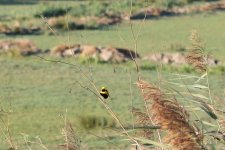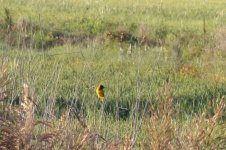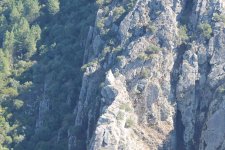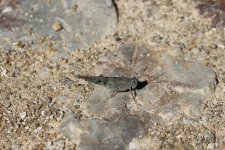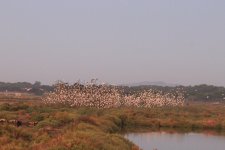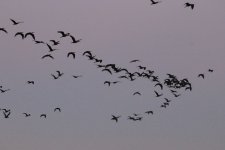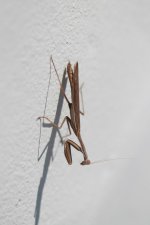Paul Chapman
Well-known member
I booked a short holiday with my wife to Portugal via Faro to allow me to chase a couple of targets in the south of the country before heading north to chase plastic and the Ruppell’s Vulture at Portas de Rodao. The usual arrangements were made through the lazy but convenient route of Easyjet and Europcar. A quick scan of the Internet produced hotels near Faro airport, Alcochete and Castelo Branco without any difficulty.
In light of the fact that I only planned a day in the south and it was a bloody stupid time of year to be chasing my targets, I arranged to meet up with Georg Schreier - http://www.birdwatching-algarve.com/ - to increase my prospects of White-rumped Swift and Western Orphean Warbler. I thoroughly recommend his ability and his style to anyone thinking about such a trip. He was clearly very knowledgeable and knew the area and its birds very well.
We arrived after dark at Faro airport on 4th September. Collecting the hire car was straightforward. We needed a good night’s sleep so settled upon a hotel within a few minutes of the airport.
The next morning, 5th September, we set off at 6.30am. We spent the day doing some birding just north of Faro targeting Western Orphean Warbler in a lovely secluded wooded valley before heading across towards and north of Castro Marim for White-rumped Swift and then up to and around Mertola to try our luck in a vulture search. Despite spending the day primary chasing a couple of specific species, a total of over 70 species were recorded pretty easily including that important tick of White-rumped Swift. The wooded valley produced a nice range of species including 3 Alpine Swift, Bee-eater, Short-toed Eagle, Little Owl, Redstart, Sardinian Warbler, Western Bonelli’s Warbler, Iberian Chiffchaff, Spotted and Pied Flycatcher, Nuthatch, Short-toed Treecreeper and Hawfinch. Despite a prolonged effort over about a hour from first sound, Western Orphean Wabler proved hideously illusive. It failed to show and as I do not tick heard only birds failed to make it onto my list. Better luck was had with the next target. The white-rumped swift site produced very good views of a single juvenile/first-winter. It also produced 5 Black Stork flying south with a number of Bee-eaters doing the same and plentiful Crag Martins and Subalpine and Dartford Warblers. The vulture search produced 3+ Raven, an immature Bonelli’s Eagle, an immature Golden Eagle, 2+ Short-toed Eagle, Common Buzzard, 4 Black Vulture and about 100 Griffon Vultures. Despite looking hard at a slightly odd Griffon Vulture it certainly was no Ruppell’s – alas! En route between various other locations and generally produced flocks of Azure-winged Magpies, Northern and 2 Western Black-eared Wheatears, another Short-toed Eagle, 2+ Little Ringed Plover, Common Sandpiper, Pallid Swift, several Cattle Egret, Tawny Pipit, Yellow Wagtail, Thekla Lark, Pallid Swift, Southern Grey and Woodchat Shrikes, Spotless Starling and Bee-eaters. Red-rumped Swallows were plentiful.
Having left Faro at around 6.00pm and stopped for fuel and something to eat, we finally found our hotel at Alcochete around 9.30pm. An early start on 6th September was required to tread the well-worn path of plastic chasing around Lisbon. Nevertheless a quick check of the estuary near our hotel revealed at least 10 Kentish with 30 Ringed Plover, 10 Sanderling and 5 Turnstone. We tried the usual site of Barroco de Alva and thereafter Rilvas for the usual plastic. Black-headed Weaver, Yellow-crowned Bishop and Common Waxbill were pretty conspicuous but no Black-headed Munia were seen. As well as the usual nonsense, proper birds were plentiful. Highlights were 2 Black-shouldered Kite – one at each location. Other proper birds seen included numerous Cattle Egrets, a single Spoonbill, White Storks, Glossy Ibises, Greater Flamingos, Marsh Harriers, a single Hoopoe and Cetti’s and Fan-tailed Warblers. The next stop was the Crested Myna site at Carcavelos. This produced views of the Mynas – at least four - and plentiful cafes – where we grabbed lunch. A single Sandwich Tern was the only brief proper distraction. Leaving there after lunch, we arrived at Portas de Rodao mid-afternoon. A check from the layby en route to the viewpoint failed to produce the target with only about 10 Griffon Vulture obvious but on picking up my bins at the viewpoint, the second vulture down in a row of about 10 was plainly interesting. Hastily arranging my scope produced the confirmation sought with good views of the resident Ruppell’s Vulture over the next three hours with 40 to 50 Griffons in the area.
We had planned two nights at Castelo Branco if necessary to allow repeated attempts at Portas de Rodao but as this was not necessary thoughts turned back to the Munia. Well mine any way! I think my wife quite liked the hotel in Castelo Branco on a hill overlooking the town but the idea of cutting down on the last day driving won the day. So the next morning, 7th September, we headed back towards Lisbon and settled during the afternoon and evening to bird Zambujal near Setubal – staying just outside Setubal. Birding for the rest of the day and the following morning proved this site to be cracking with plenty of proper birds. Again various pieces of plastic were obvious with Common Waxbill and Yellow-crowned Bishop. No Black-headed Weavers were seen here. However, what was most impressive was a fantastic Cattle Egret roost that probably numbered around 1,000 and included around 300 Glossy Ibis. Waders were also well represented on the Sado Estuary with Ringed and Kentish Plovers, Dunlin, Common and Green Sandpipers, Common and Spotted Redshank, Greenshank, Black-tailed Godwit, Avocet, Knot and Black-winged Stilt. Again White Storks and Greater Flamingos were much in evidence together with a number of Spoonbills and on the morning of 8th September a single Purple Heron. Raptors included numerous Marsh Harriers and 2 Booted Eagles and other birds included a single Hoopoe, Cetti’s, Sedge, Reed and Fan-tailed Warblers and a single Nightingale. However, there was no sign of the hoped for Black-headed Munia.
The journey back to Faro mid-morning on 8th September produced another Black-shouldered Kite from the car. I managed to fight the desire to have another crack at Western Orphean Warbler in the secluded valley and spent the balance of the day around Faro marshes and at Praia de Faro. I found Purple Gallinule on the same lagoon and along the same reed fringe as I ticked it over twenty years before on my only other trip to Portugal with my parents on a family holiday. The pools near Ludo Farm were pretty much how I remembered them with Pochard, Gadwall, Greater Flamingos, 2 Caspian Terns and a selection of waders as well as in the nearby woods plenty of Azure-winged Magpies and a Wryneck. A pleasant afternoon was then spent having a drink and something to eat overlooking the beach and causeway at Praia de Faro. This produced 10+ Gannet, 4+ Mediterranean Gulls, Sandwich and Little Terns and Grey Plover and Bar-tailed Godwit as addition to the trip wader list. The final species tally was 125 and a cracking diversity of species had been seen without a great deal of effort – simply sampling a few habitats whilst chasing a couple of specific targets. A cracking destination thoroughly recommended.
Some photos attached but as my only lens was a 100mm macro in anticipation of some insects – this made what would have been a challenging attempt at photographing the Ruppell’s Griffon Vulture pure comedy. So attached – Yellow-crowned Bishop (Barraco de Alva 05.09.11); Black-headed Weaver (Barraco de Alva 05.09.11); cliff face with if you look very carefully four vultures on a triangular white rock in the centre of the photo including the adult Ruppell’s Griffon (Portas de Rodao 06.09.11); Grasshopper sp. – Blue-winged? (Portas de Rodao 06.09.11); Cattle Egret and Glossy Ibis Roost (Zambujal 08.09.11); Glossy Ibis leaving roost (Zambujal 08.09.11); & Praying Mantis (Castro Verde 08.09.11).
All the best
Paul Chapman
In light of the fact that I only planned a day in the south and it was a bloody stupid time of year to be chasing my targets, I arranged to meet up with Georg Schreier - http://www.birdwatching-algarve.com/ - to increase my prospects of White-rumped Swift and Western Orphean Warbler. I thoroughly recommend his ability and his style to anyone thinking about such a trip. He was clearly very knowledgeable and knew the area and its birds very well.
We arrived after dark at Faro airport on 4th September. Collecting the hire car was straightforward. We needed a good night’s sleep so settled upon a hotel within a few minutes of the airport.
The next morning, 5th September, we set off at 6.30am. We spent the day doing some birding just north of Faro targeting Western Orphean Warbler in a lovely secluded wooded valley before heading across towards and north of Castro Marim for White-rumped Swift and then up to and around Mertola to try our luck in a vulture search. Despite spending the day primary chasing a couple of specific species, a total of over 70 species were recorded pretty easily including that important tick of White-rumped Swift. The wooded valley produced a nice range of species including 3 Alpine Swift, Bee-eater, Short-toed Eagle, Little Owl, Redstart, Sardinian Warbler, Western Bonelli’s Warbler, Iberian Chiffchaff, Spotted and Pied Flycatcher, Nuthatch, Short-toed Treecreeper and Hawfinch. Despite a prolonged effort over about a hour from first sound, Western Orphean Wabler proved hideously illusive. It failed to show and as I do not tick heard only birds failed to make it onto my list. Better luck was had with the next target. The white-rumped swift site produced very good views of a single juvenile/first-winter. It also produced 5 Black Stork flying south with a number of Bee-eaters doing the same and plentiful Crag Martins and Subalpine and Dartford Warblers. The vulture search produced 3+ Raven, an immature Bonelli’s Eagle, an immature Golden Eagle, 2+ Short-toed Eagle, Common Buzzard, 4 Black Vulture and about 100 Griffon Vultures. Despite looking hard at a slightly odd Griffon Vulture it certainly was no Ruppell’s – alas! En route between various other locations and generally produced flocks of Azure-winged Magpies, Northern and 2 Western Black-eared Wheatears, another Short-toed Eagle, 2+ Little Ringed Plover, Common Sandpiper, Pallid Swift, several Cattle Egret, Tawny Pipit, Yellow Wagtail, Thekla Lark, Pallid Swift, Southern Grey and Woodchat Shrikes, Spotless Starling and Bee-eaters. Red-rumped Swallows were plentiful.
Having left Faro at around 6.00pm and stopped for fuel and something to eat, we finally found our hotel at Alcochete around 9.30pm. An early start on 6th September was required to tread the well-worn path of plastic chasing around Lisbon. Nevertheless a quick check of the estuary near our hotel revealed at least 10 Kentish with 30 Ringed Plover, 10 Sanderling and 5 Turnstone. We tried the usual site of Barroco de Alva and thereafter Rilvas for the usual plastic. Black-headed Weaver, Yellow-crowned Bishop and Common Waxbill were pretty conspicuous but no Black-headed Munia were seen. As well as the usual nonsense, proper birds were plentiful. Highlights were 2 Black-shouldered Kite – one at each location. Other proper birds seen included numerous Cattle Egrets, a single Spoonbill, White Storks, Glossy Ibises, Greater Flamingos, Marsh Harriers, a single Hoopoe and Cetti’s and Fan-tailed Warblers. The next stop was the Crested Myna site at Carcavelos. This produced views of the Mynas – at least four - and plentiful cafes – where we grabbed lunch. A single Sandwich Tern was the only brief proper distraction. Leaving there after lunch, we arrived at Portas de Rodao mid-afternoon. A check from the layby en route to the viewpoint failed to produce the target with only about 10 Griffon Vulture obvious but on picking up my bins at the viewpoint, the second vulture down in a row of about 10 was plainly interesting. Hastily arranging my scope produced the confirmation sought with good views of the resident Ruppell’s Vulture over the next three hours with 40 to 50 Griffons in the area.
We had planned two nights at Castelo Branco if necessary to allow repeated attempts at Portas de Rodao but as this was not necessary thoughts turned back to the Munia. Well mine any way! I think my wife quite liked the hotel in Castelo Branco on a hill overlooking the town but the idea of cutting down on the last day driving won the day. So the next morning, 7th September, we headed back towards Lisbon and settled during the afternoon and evening to bird Zambujal near Setubal – staying just outside Setubal. Birding for the rest of the day and the following morning proved this site to be cracking with plenty of proper birds. Again various pieces of plastic were obvious with Common Waxbill and Yellow-crowned Bishop. No Black-headed Weavers were seen here. However, what was most impressive was a fantastic Cattle Egret roost that probably numbered around 1,000 and included around 300 Glossy Ibis. Waders were also well represented on the Sado Estuary with Ringed and Kentish Plovers, Dunlin, Common and Green Sandpipers, Common and Spotted Redshank, Greenshank, Black-tailed Godwit, Avocet, Knot and Black-winged Stilt. Again White Storks and Greater Flamingos were much in evidence together with a number of Spoonbills and on the morning of 8th September a single Purple Heron. Raptors included numerous Marsh Harriers and 2 Booted Eagles and other birds included a single Hoopoe, Cetti’s, Sedge, Reed and Fan-tailed Warblers and a single Nightingale. However, there was no sign of the hoped for Black-headed Munia.
The journey back to Faro mid-morning on 8th September produced another Black-shouldered Kite from the car. I managed to fight the desire to have another crack at Western Orphean Warbler in the secluded valley and spent the balance of the day around Faro marshes and at Praia de Faro. I found Purple Gallinule on the same lagoon and along the same reed fringe as I ticked it over twenty years before on my only other trip to Portugal with my parents on a family holiday. The pools near Ludo Farm were pretty much how I remembered them with Pochard, Gadwall, Greater Flamingos, 2 Caspian Terns and a selection of waders as well as in the nearby woods plenty of Azure-winged Magpies and a Wryneck. A pleasant afternoon was then spent having a drink and something to eat overlooking the beach and causeway at Praia de Faro. This produced 10+ Gannet, 4+ Mediterranean Gulls, Sandwich and Little Terns and Grey Plover and Bar-tailed Godwit as addition to the trip wader list. The final species tally was 125 and a cracking diversity of species had been seen without a great deal of effort – simply sampling a few habitats whilst chasing a couple of specific targets. A cracking destination thoroughly recommended.
Some photos attached but as my only lens was a 100mm macro in anticipation of some insects – this made what would have been a challenging attempt at photographing the Ruppell’s Griffon Vulture pure comedy. So attached – Yellow-crowned Bishop (Barraco de Alva 05.09.11); Black-headed Weaver (Barraco de Alva 05.09.11); cliff face with if you look very carefully four vultures on a triangular white rock in the centre of the photo including the adult Ruppell’s Griffon (Portas de Rodao 06.09.11); Grasshopper sp. – Blue-winged? (Portas de Rodao 06.09.11); Cattle Egret and Glossy Ibis Roost (Zambujal 08.09.11); Glossy Ibis leaving roost (Zambujal 08.09.11); & Praying Mantis (Castro Verde 08.09.11).
All the best
Paul Chapman
Attachments
Last edited:




